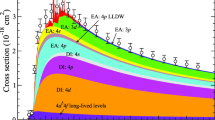Abstract
A theoretical study of the (H2O)2 dimer has been carried out in which the lowest S1 and T1 excited electronic states of the dimer complex, the influence of hydrogen bond formation on the shift in the maximum of the absorption band, and the stability of the dimer complex in the ground and excited states have been examined. It was found that there is only a single global maximum for the system — a nonplanar dimer complex formed by a linear hydrogen bond. Cyclic and bifurcated structures are transition states which do not form stable configurations when electronically excited. For the structure having a minimum in the ground electronic state, two nondissociating S1 and T1 states were found with bond energies of 2.0 and 4.4 kcal/mole, respectively. Formation of hydrogen bonds leads to a shift in the absorption maximum to the blue region with respect to the monomer. The hydrogen bond was found to weaken in the excited electronic states of the dimer.
Similar content being viewed by others
Literature cited
T. R. Dyke and J. S. Muenter, J. Chem. Phys.,60, No. 7, 2929–2930 (1974).
T. R. Dyke, K. M. Mack, and J. S. Muenter, J. Chem. Phys.,66, No. 2, 498–510 (1977).
J. A. Odutova and T. R. Dyke, J. Chem. Phys.,72, No. 9, 5062–5070 (1980).
P. Khobza and R. Zagradnik, Intermolecular Complexes [Russian translation], Mir, Moscow (1989).
A. A. Vigasin, Zh. Strukt. Khim.,24, No. 1, 116–141 (1983).
L. A. Curtiss, D. J. Frurip, and M. Blander, J. Chem. Phys.,71, 2703–2710 (1979).
L. A. Curtiss and J. A. Pople, J. Mol. Spectrosc.,55, 1–5 (1975).
R. J. Vos, R. Hendriks, and F. B. van Dneijneveldt, J. Comput. Chem.,11, No. 1, 1–18 (1990).
J. Colin and U. A. Marsden, J. Chem. Phys.,95, No. 3, 1825–1828 (1991).
R. F. Verrall and W. A. Senior, J. Chem. Phys.,50, No. 6, 2746–2750 (1969).
T. T. Meister, Electronic Spectra of Polyatomic Molecules [in Russian], Leningrad State University, Leningrad (1969).
Additional information
V. D. Kuznetsov Siberian Physicotechnical Scientific-Research Institute at the State University, Tomsk, Russia. Translated from Izvestiya Vysshikh Uchebnykh Zavedenii, Fizika, No. 3, pp. 11–15, March, 1993.
Rights and permissions
About this article
Cite this article
Zvereva, N.A., Buldakov, M.A., Ippolitov, I.I. et al. Stability of the (H2O)2 dimer in the ground and lowest-lying excited electronic states. Russ Phys J 36, 195–199 (1993). https://doi.org/10.1007/BF00559618
Received:
Issue Date:
DOI: https://doi.org/10.1007/BF00559618




